Weapons on the principle of "two in one"
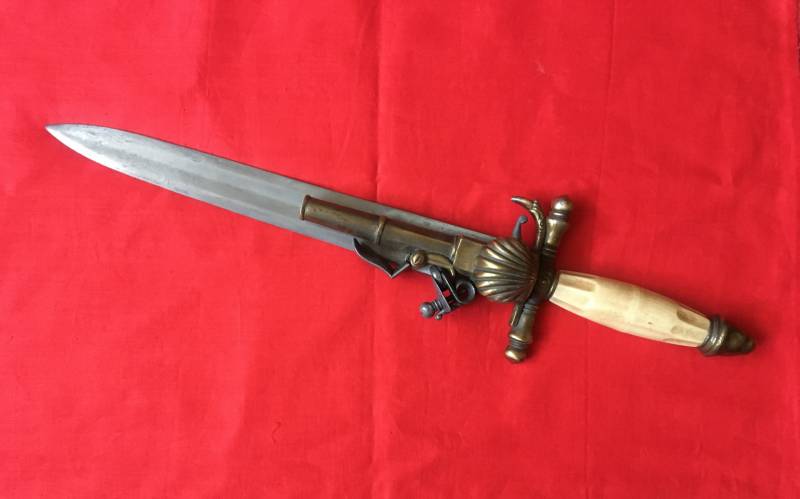
A hunting dagger from the arsenal of the Czech castle Gluboka nad Vltavou, or rather, a souvenir copy of it. The flint lock of the percussion pistol functions, so that it can be clicked if desired. "Thing" is very funny ... Photo by the author
and reap its harvest,
and others to do military weapon
and equipment for his chariots.
8 Samuel 12:XNUMX
Weapon stories. Monotony is depressing. A person engaged in monotonous work or, say, making the same products for a long time, gets tired more than someone who performs work consisting of various operations, or one of his products is not like another. And this applies to both journalists (I judge by myself. - Approx. Author), and ... blacksmiths. That is, it is clear that in the past they had such a job - to forge horses, axes, and even swords, and there were also high-class master swordsmen and halberdiers, whose even one-time products look like unique ones.
And yet, for sure, many of them wanted to make something that would be special, not like the rest of the "handicrafts" and, as they say, take their souls away from it. But there could be original customers - "people who want the strange", and after all, weapons could also be strange. And the easiest way was to make such a weapon curiosity by combining any two different types of weapons in one thing. Here we will tell you today about such and such a combined weapon of the past.
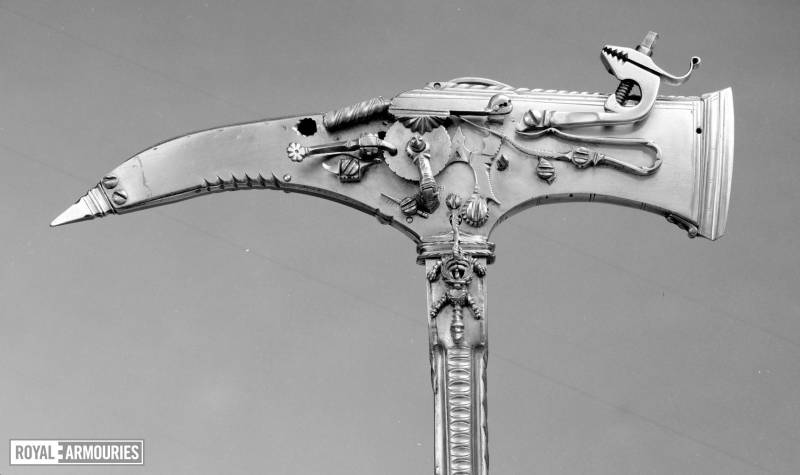
Among the exhibits of the White Tower of the Tower of London, there is such a battle tomb (1600-1630). It has a total length of 554 mm and consists of a head and a handle. Head length 381 mm. Weight 2 g. But the most interesting thing about it is hidden inside. Firstly, on both sides of the warhead there are two locks at once - a wick and a wheel lock. Secondly, under the cover covering the flat part of the head part, five trunks are hidden at once, and one more trunk, the sixth, is in his handle! The uppermost barrel is ignited by a matchlock mounted on the right side, the mechanism of which is covered with a brass plate in the form of a lion, the second - by a wheel lock, the mechanism of which occupies most of the outer surface of the ax tip on the left side. On the opposite side, the remaining three barrels are ignited with a wick, as well as the sixth barrel, located in the handle. There is a tubular extension in the pan of the wheellock designed to hold a length of wick that is ignited when the lock is actuated and then pulled out so that it can light the rest of the barrels. Tricky mechanic, right? And how much it was necessary to train in order to bring the skill of “working” with such a shooting bait to automatism!

The British also had simpler weapons. This combi-sword is a 1520 estok with a screw-down handle, inside of which there was a barrel loaded with a bullet. By the way, its length is not at all small - 1 mm. Like this, you wave this sword at yourself, and then turned the handle towards the enemy, applied the wick and ... bang! Royal Arsenal, Leeds
Perhaps it was the axes, and even the maces and six-pointers, that were most suitable for making them shooters. Even Henry VIII walked around London at night with such a shooting spiked club, and subsequently the tradition of turning axes and maces into pistols was continued.
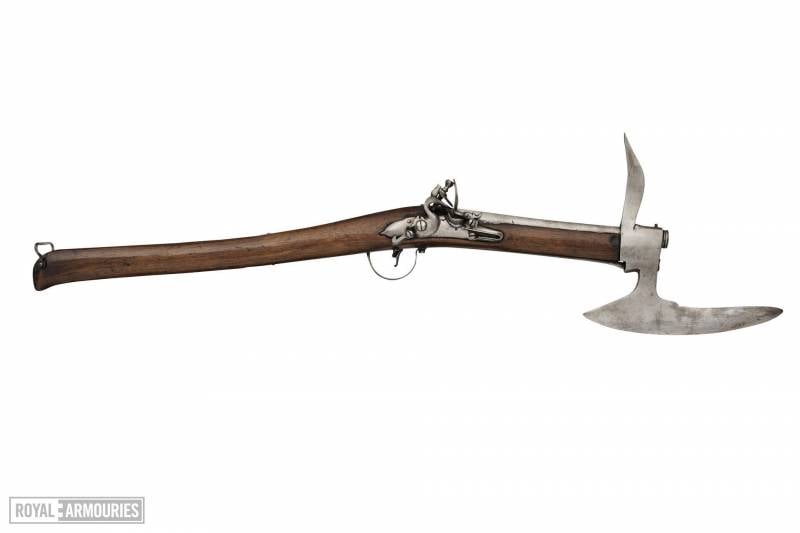
Here, for example, is a Swedish boarding ax from 1703. Total length 823 mm. Barrel length 247 mm. Weight 1,5 kg. Royal Arsenal, Leeds
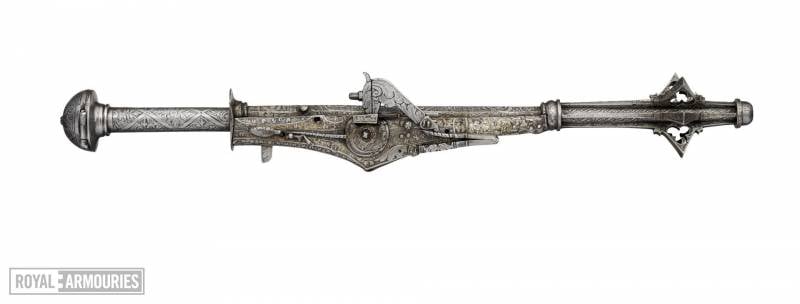
And this is a shestoper (six "feathers"), connected to a pistol of 1560. The nibs are slotted, and in general, both the lock and the handle are finished with rich carvings and metal etching. Overall length 616 mm, barrel length 338 mm. Weight 1,72 kg. Caliber 7,8 mm. Royal Arsenal, Leeds
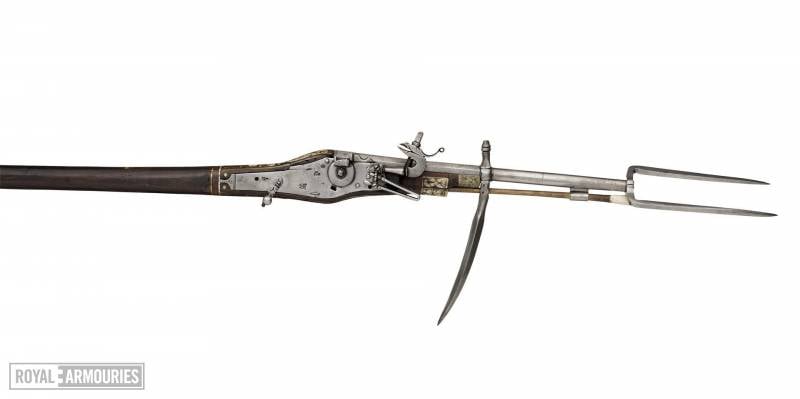
One can only envy the ingenuity of the creator of this instrument of death. Here you have a slander on a long shaft, and a pistol, moreover, a combat pitchfork is fixed on its barrel! Overall length 1 mm, barrel length 942 mm. Royal Arsenal, Leeds

There is a similar combination of halberd, pistol and fork in the collection of the Metropolitan Museum of Art in New York.
In fact, the idea of putting a pistol barrel on a halberd or on a spear left a noticeable mark on the weapon art. And really, what's the point of lugging around with a heavy gun in order to end up hitting it from a maximum of thirty steps and then fighting with it like a club, or inserting a baguinet into the barrel?
Much more profitable was the weapon in the form of a halberd, which was already armed in many armies for officers and honorary guards, but ... attach one or two pistol barrels to it. It was difficult to miss at close range, but if you missed, you are still not unarmed!
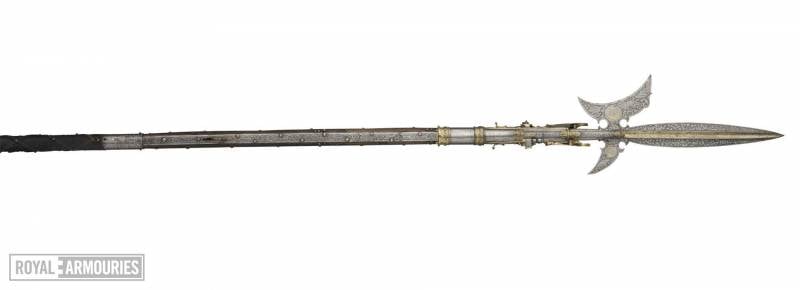
A combination of a double-barreled wheeled pistol and a 1590 halberd. Overall length 2 mm. Barrel length 127 mm. Weight 203 kg. Royal Arsenal, Leeds
A hybrid of a spear, or rather a spear, and a pistol in hunting began to be widely used.
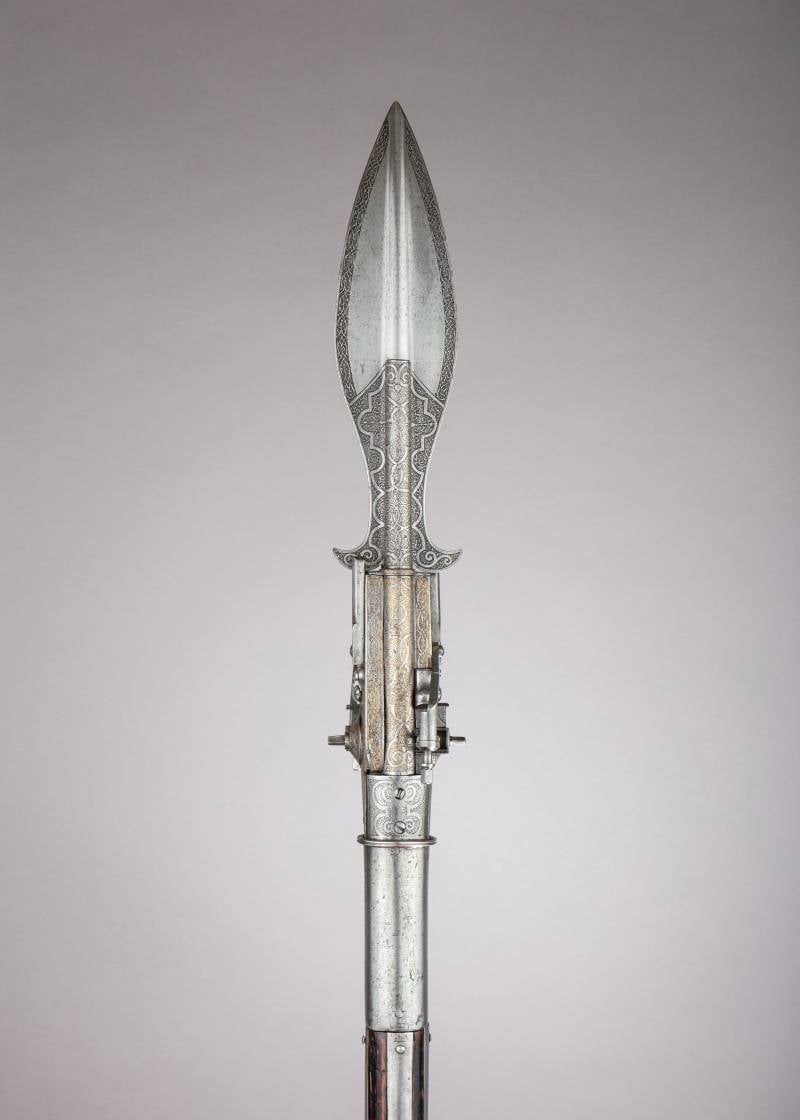
Here, for example, is a 1575 Saxon horn for hunting a wild boar. Length 195,6 cm; the length of the barrels is 24,3 cm. As for the caliber, one barrel has 10,31 mm, and the other has 10,47 mm. However, since the bullets were still wrapped in paper or leather, this did not play a special role. The weight of the weapon is 3,665 kg. It is interesting that some of these spears had an original trigger: either the barrel itself was fed back, or the “horns” were the triggers for such a spear. As soon as the tip penetrated deep enough into the carcass of the beast, a double shot at close range followed! Metropolitan Museum of Art, New York
But back to axes, because among them there are very interesting examples of combined weapons ...
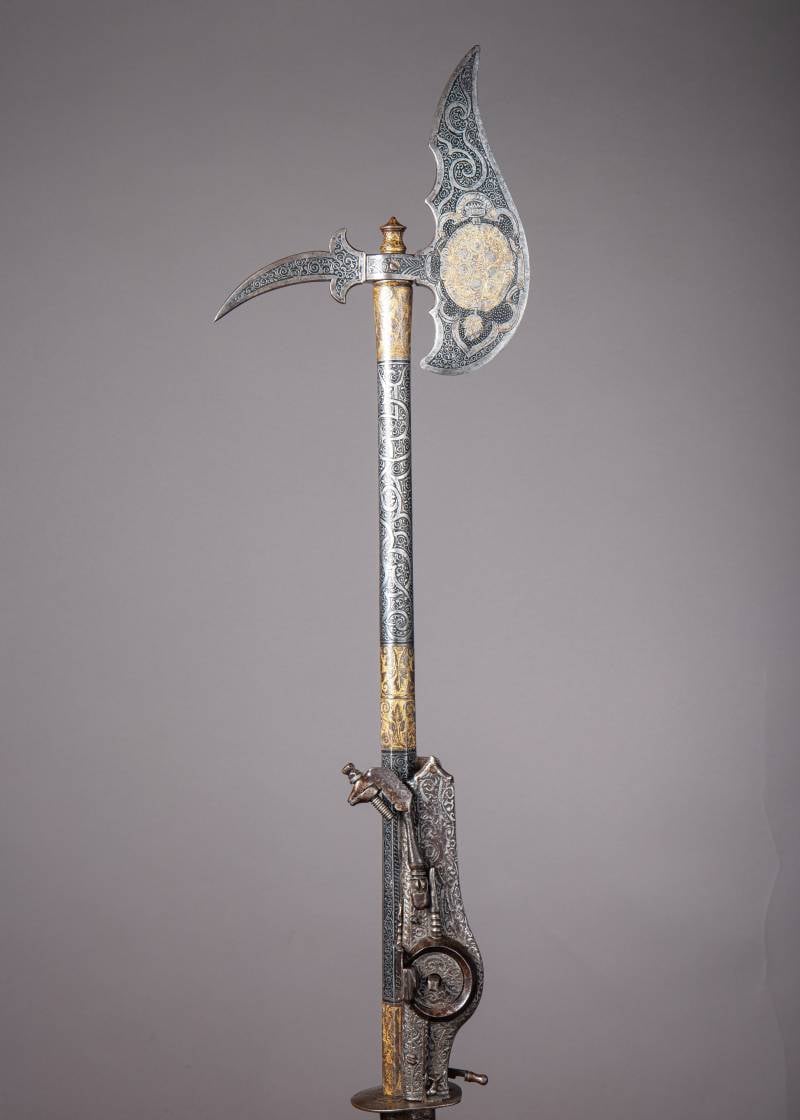
Before us is a truly luxurious combined ax-pistol of the Grand Duke Ferdinand I of Medici (1549-1609), made in Germany ca. 1580. Metropolitan Museum of Art, New York
At that time, the combination weapon was especially attractive to a wealthy nobleman as a carefully thought-out mechanical rarity, so they were both willingly produced and just as willingly acquired. It was, quite simply, prestigious to own such a weapon at that time. This ax pistol, like most examples of German production, has an all-steel construction, in which the hollow ax shaft serves as the pistol barrel, and the lock is attached to its outside. The handle ends in a hollow pommel consisting of two articulated halves, and was probably used to store pyrite, cotton wool, bullets, or even auxiliary tools.
The front end of the shaft is provided with an s-shaped ax blade and a curved spike behind it; the barrel opening is closed with a baluster-shaped plug, which should have been removed before the pistol was fired. The surfaces of the ax handle, shaft and lower half of the pommel are engraved with a weave of straps and volutes on a blackened background, with accentuated areas of gilded foliage, in the South German style used in Augsburg and Nuremberg. The presence of the Medici coat of arms indicates that these arms were made after December 1569, when Cosimo I de' Medici (1519–1574, reigned from 1537) became Grand Duke of Tuscany.
Its owner, however, was not Cosimo himself, but his second son, Cardinal Ferdinand (1549–1609), who ruled from 1587. The ax pistol is first mentioned in the Medici archives in 1589, when it was privately owned by Ferdinand, in his armory at his residence at Palazzo Pitti in Florence. There it was clearly described, including the hilt, which was now plain, covered in black velvet fringed with black silk and gold. All weapons were stored in a black leather case fitted with black velvet cords and tassels of black silk and gold. Ax length 70 cm.
However, the axes with which the gunners were armed are also known, and they were combined not with pistols, but with ... a quadrant!
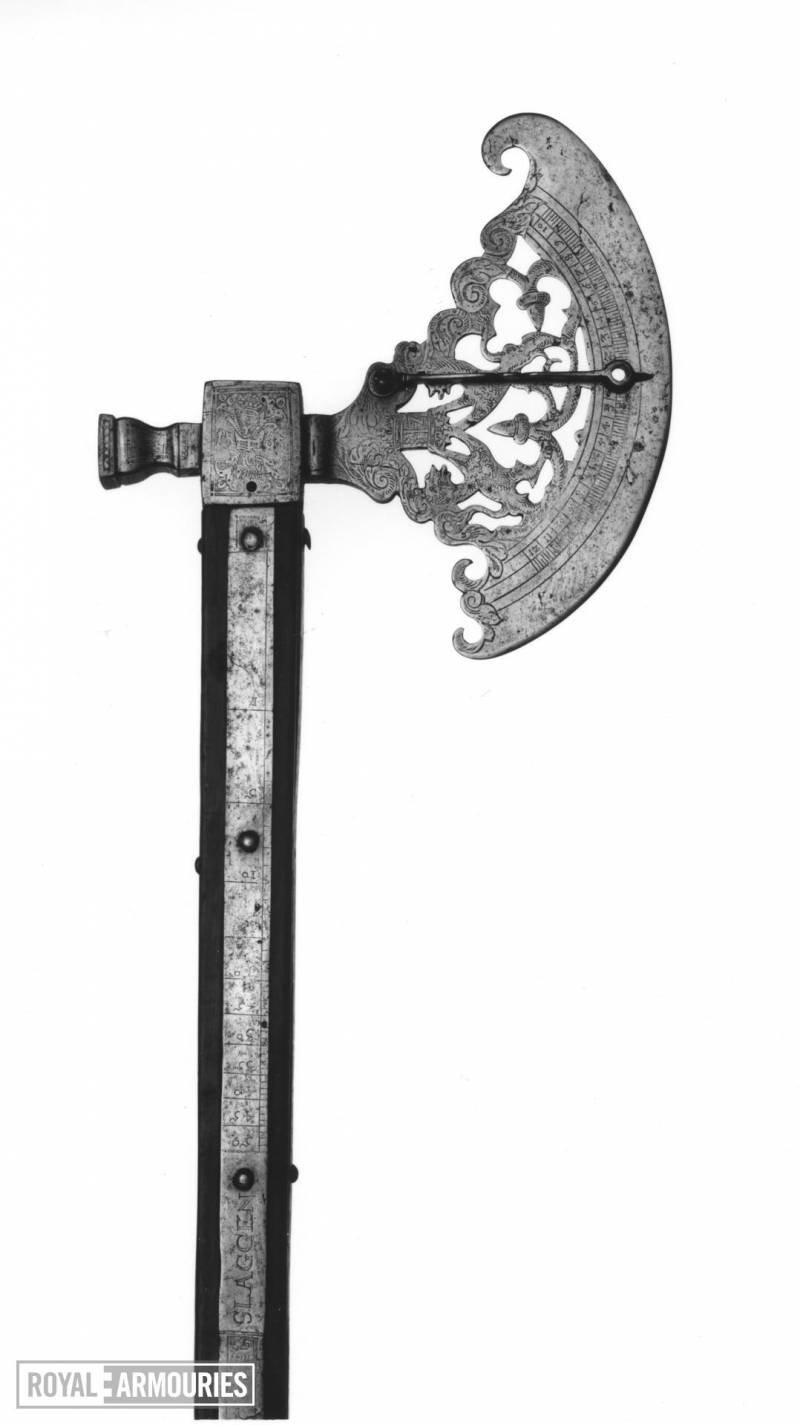
The dial has the shape of an ax blade and is balanced by a hammer on the opposite side. The dial is perforated and decorated with acorns and two ferocious lions supporting a shield in a crown with the IHSZ monogram. A rotary pointer or pendulum marks the degrees of altitude in a quadrant engraved on the edge of the dial, calibrated from 1 to 12 and 1 to 10 from the center. The rosette is engraved with the insignia of the Order of the Golden Fleece in fire-resistant steel and the date 1585. Royal Arsenal, Leeds
They worked with such an ax as follows: the handle was placed in the bore of the gun barrel, which was raised until the arrow showed the desired elevation angle on the dial-blade.
It is not surprising that in the XNUMXth century a shooting barrel was attached to a sword. It would be amazing if they didn't!
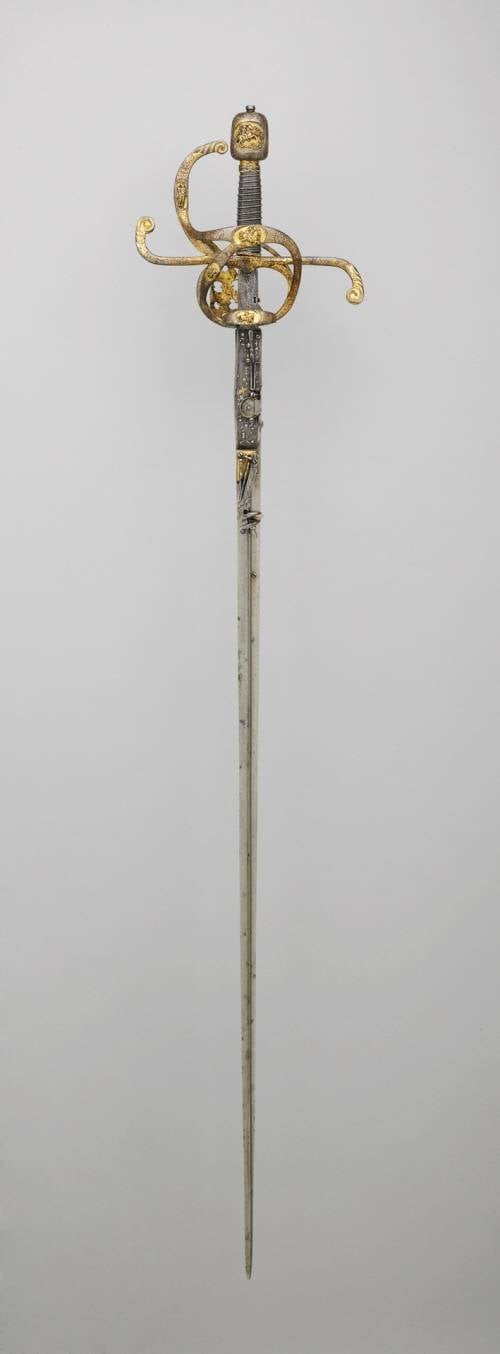
Rapier pistol, ca. 1580–1590 Germany, Augsburg. The pommel is decorated with a gilded brass insert depicting St. George and the dragon, the guards are decorated with two equestrian figures in classical armor and the figure of Lucretia, and all this is decorated with flowers and foliage, and in addition gilded. The blade is diamond section, ribbed in the center, the edges are concave. A small wheeled pistol is attached in an unusual way: the barrel is to the left of the blade, the lock is to the right. The shot is made using a button attached to the ricasso and controlled by the thumb. Length: 121,8 cm. Blade length: 105,8 cm. Blade width at ricasso: 2,6 cm. Weight: 1,59 kg. Metropolitan Museum of Art, New York
It is interesting that the fashion for such weapons has passed through the centuries, so that individual samples were made even in the XNUMXth century!
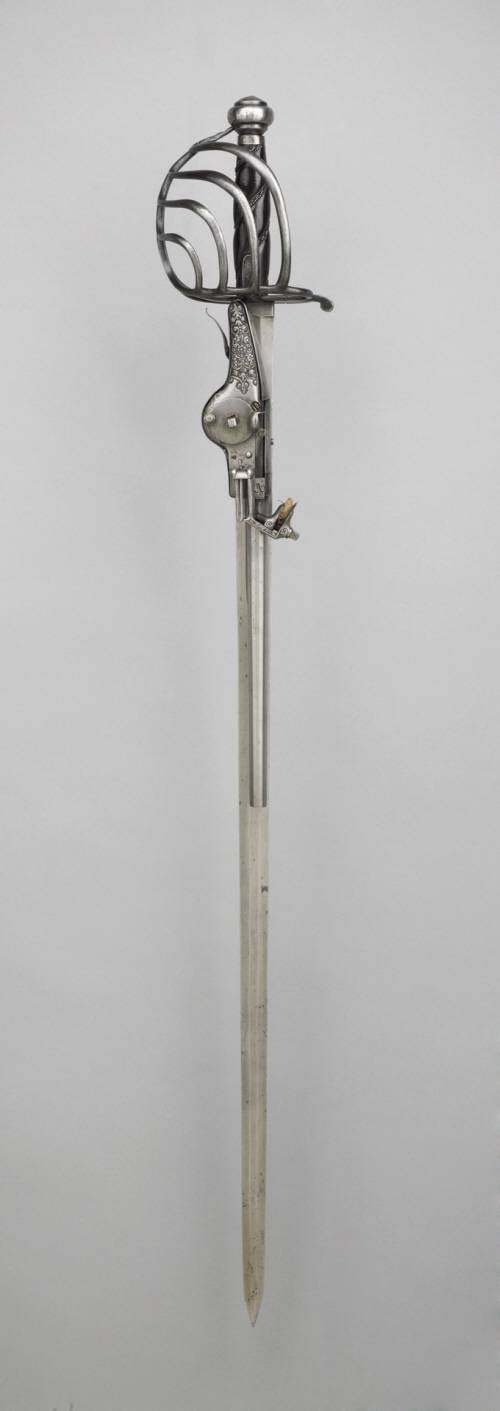
Broadsword with a pistol with a wheel lock. Netherlands. 1785 (broadsword), 1640 (castle). Overall length: 109,2 cm. Blade length: 92,7 cm. Blade width: 3,6 cm. Weight: 2,37 kg. Blued steel basket handle with flattened spherical buttonless pommel with spiral grooves, wooden handle wrapped in grooved steel wire. On the inside is a large thumb ring. Wide flattened hexagonal blade with a shallow groove. On the right side, under the handle, a pistol wheel lock is attached. The barrel is octagonal in the breech and round the rest of the length. The pistol is fired with a flat, curved trigger protruding rearward from the casing surrounding the lock. Metropolitan Museum of Art, New York
Similar weapons were used, again, on the hunt, as in the case of the horn, these were hybrids of a hunting sword and a pistol.
But later hybrids of a hairpin revolver and a saber are also known! It is difficult to say what combat value such a weapon represented.

Here, for example, is a rather strange weapon of an incomprehensible type, made in Belgium in 1870. Overall length: 665 mm. Blade length: 487 mm. For some reason, a hairpin revolver is attached to the barrel! Royal Arsenal, Leeds
Already during the Second World War, Japan produced a hybrid of a samurai sword with a Nambu pistol, but you can’t call such a combination anything other than stupidity!
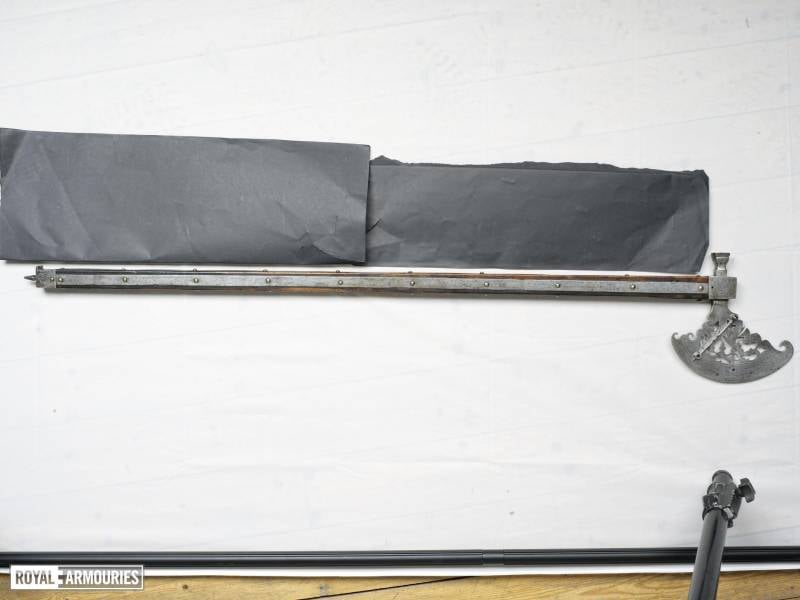
Information